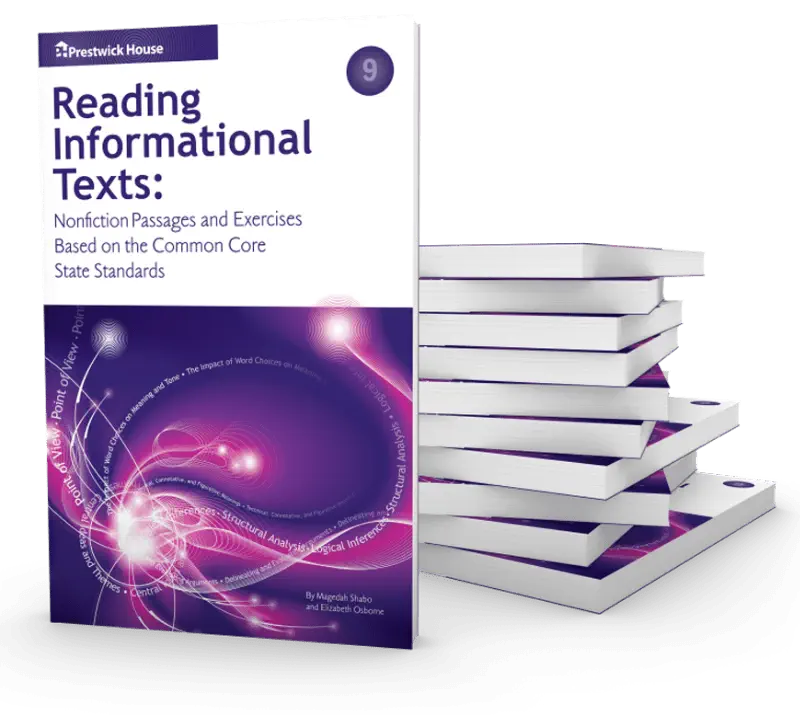The vast majority of texts are written for one or more of these three purposes:
- To make an argument
- To inform
- To tell a story
To achieve these purposes, authors use one or more of the following 5 text structures:
- Description
- Sequence/Instruction/Process
- Cause/Effect
- Compare/Contrast
- Problem/Solution
In the case of informational texts, students must learn to unpack and study the components of these five underlying text structures in order to fully understand what they're reading, whether they’re tackling a nonfiction article, analyzing a scientific report, or diving into a textbook.
1. Description
This is pretty straightforward. Texts that use this structure simply describe something. With few exceptions, these texts also present plenty of details about what they're describing.
A text using this structure might also:
- Tell you why something is being described
- Tell you why the described topic is important
- Provide examples of the described topic(s)
Descriptive texts are everywhere—in novels, works of literary nonfiction, news articles, science textbooks—which makes sense because the entire point of description is to present information.
2. Sequence/Instruction/Process
This text structure covers a few purposes:
- Sequential instructions (Step 1, Step 2, Step 3; do this, then do that, and finally do this)
- Chronological events (This happened, then this happened, then this happened, etc.)
- Arguments that use evidence to support a claim (presenting evidence from least to most convincing)
When students read or write a text with this structure, order is key. Texts that use this format usually don't present any event or instruction out of order, as doing so would make its directions more difficult to follow.
As a ludicrous example, imagine a cake recipe in which preheating the oven is the last step. It would just be confusing and odd. Poorly written instructions just aren't worth your time.
Here is a non-exhaustive list of words and phrases that indicate a text follows the sequence/instruction/process text structure:
| after |
before |
during |
earlier |
| eventually |
finally |
first |
from |
| how to |
in order |
last |
meanwhile |
| next |
now |
until |
while |
3. Cause/Effect
The Cause/Effect text structures explain, well, causes and effects. Sounds pretty simple! But texts that use this structure can become complex when an effect has multiple causes (or vice versa).
Students will encounter complex examples of cause-effect when they read historical texts. Many events in history had more than one cause, all related in ways that can be difficult to unpack.
Here is a non-exhaustive list of words and phrases that indicate a text follows the cause/effect text structure:
| because |
cause |
led to |
reason |
| accordingly |
effect |
result |
consequence |
4. Compare/Contrast
This text structure involves a comparison involving multiple things, revealing how they are similar and how they are different.
Make sure your students know that contrasting two or more things doesn't necessarily mean identifying them as either good or bad. Comparisons simply relay the differences; therefore, one thing could have both positive and negative traits.
Here is a non-exhaustive list of words and phrases that indicate a text follows the compare/contrast text structure:
| alike |
also |
both |
comparable |
| even |
in common |
just as |
similar |
| although |
but |
despite |
difference |
| however |
instead |
otherwise |
unlike |
5. Problem/Solution
This text structure involves two parts:
- The author identifies a problem
- The author details a solution to this problem
Problem/Solution can be a very complex text structure, as it necessitates the use of other structures, too. Clearly, the author needs to describe the problem. The author would likely also explain the causes and effects of the problem in order to argue in favor of their solution. Does implementing the author's solution involve following a series of specific steps? That involves another structure. What if the author wants to mention other potential solutions and then explain why their solution is the best one? Oh, hello there, Compare/Contrast!
What's important here, as it is with any text in which an author marshals an argument, is that the author uses only the information needed to advance the argument or refute counterarguments. When students examine a text that uses the Problem/Solution text structure, they should examine at least two things: the argument as a whole and the individual components of it.
Knowing that aspects of other text structures might appear in the Problem/Solution one will help students examine the argument's individual components. That's why it's essential that students understand and can analyze the other four structures if you want them to be able to examine Problem/Solution effectively.
Take a Closer Look at Informational Text Structures

Looking for a series that makes it easy to teach informational material to middle and high school students? Try Reading Informational Texts, available for grades 7–12. Each book in this series offers challenging nonfiction passages paired with short-answer and essay questions that focus on the content. Free sample pages are available for download at your convenience. Simply fill out the form to preview reading passages for all levels of the program.